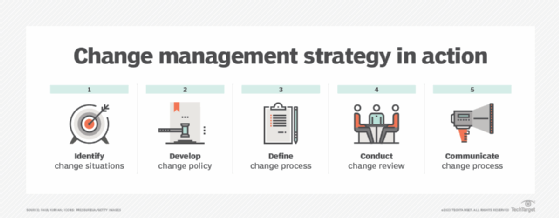organizational change management (OCM)
What is organizational change management (OCM)?
Organizational change management (OCM) is a type of change management framework for managing the effect of new business processes, changes in organizational structure or cultural changes within an enterprise.
Every organization goes through changes or transitions periodically during its existence. These changes can have a significant impact on the business and its processes, company output, people, and other stakeholders. In some cases, the impact can be negative, affecting the company's reputation or profitability. In other cases, the changes may result in greater efficiency, additional sales or new business opportunities.
To effectively deal with change while minimizing its potential negative impact, a formal organizational change management process might be required. OCM refers to all the activities and practices that enable a company to prepare for and adjust to change with minimal adverse consequences.

What causes organizational change?
There can be many factors that force some degree of change in an organization. These factors can be either external or internal. Changes in leadership or the company team structure are examples of internal factors that make organizational change necessary. Similarly, the adoption of new business or operating models, process innovations or improvements, and organizational growth are other internal change-causing factors. Ineffective internal communication, product retirements and process failures may also necessitate change.
Change can also happen due to external factors such as technological advancements and changes in market conditions. The emergence of new competitors, socio-politico-economic changes in the company's operating region or target markets, regulatory changes, and shifts in customer preferences are other examples of external causes of organizational change.
Types of organizational changes
Regardless of the cause, organizational change can be either adaptive or transformational. Adaptive changes are small changes that address evolving needs. These changes require incremental adjustments and are usually not difficult to implement.
An example of adaptive change is upgrading software or modifying a lead generation form. Updating the company website, making small tweaks to an existing product in response to customer feedback and hiring a new employee to fill an existing role are other examples of adaptive changes.
In contrast, transformational changes are large scale as well as more difficult to implement and adapt to. These changes might result in significant shifts in how the company operates and competes in its industry (hence the term transformational). Furthermore, to successfully implement transformational changes, organizations must be prepared to make major updates to their business processes, culture, strategy or technology stack.
Common examples of transformational change include the following:
- Replacing an entire team of human workers with software through robotic process automation bots.
- Implementing a completely new tool or technology that requires substantial testing and training.
- Completely restructuring the customer or employee onboarding process.
- Setting up a new department.
- Opening a new office.
- Acquiring or merging with another company.
- Completely overhauling the company website, social media presence, or app.
- Adopting an omnichannel approach to sales, service and support.
Why is organizational change management important?
Organizational change is inevitable. It is necessary for the company to adapt to its external environment and maintain a steady growth trajectory. Without an OCM framework and process, companies can struggle to adjust to change. The change might affect their existing production levels, reducing their profitability and competitiveness. Unexpected or unplanned changes can also lower employee morale and weaken the company culture.
A systematic approach to OCM can prevent such problems. The approach is especially beneficial when change requires people in the organization to learn new behaviors and skills. By formally setting expectations, employing tools to improve communication and proactively seeking ways to reduce misinformation, leadership helps stakeholders buy into a change and remain committed to the change throughout any associated discomfort.
Proper OCM demonstrates that the organization is committed to making and adapting to the change, especially if that change is expected to have a positive impact. Demonstrating such a commitment lets leadership implement appropriate strategies that could minimize resistance, garner organization-wide buy-in, and boost worker morale and workplace satisfaction.
OCM is also vital to retain the trust of customers and third parties such as vendors and suppliers. When these parties know the company has an effective process in place to deal with change, they are less likely to worry about the effect of the change on their own processes or profitability, and they are more likely to remain loyal to the firm. Their loyalty and support can directly impact the firm's profitability, scalability and growth.
Strategies to deal with organizational change
Effective OCM requires effective change preparation, change implementation and post-implementation (or follow-through) strategies.
In the preparation phase, one important strategy is to identify changes the organization might possibly face in the short-, mid-, and long-term. No one can predict every change the future might bring. However, a careful analysis of the organization's internal and external environments can reveal many changes that the company can plan and prepare for.
A detailed change roadmap along with an implementation plan for each change ensures a successful change implementation. The plan should list all the activities that must be completed to adopt the change and adjust to its aftermath. Ideally, the plan should be shared with all relevant stakeholders to ensure there is a common language for change (and change management) both inside and outside the organization.
Other useful and potentially successful OCM strategies include the following:
- Agreement on a common vision for change; no competing initiatives.
- Strong executive leadership to communicate the vision and sell the business case for change.
- A strategy for educating employees about how their day-to-day work will change.
- A concrete plan for metrics to measure whether the change is a success and follow-up plans for both successful and unsuccessful results.
- Rewards, both monetary and social, that encourage individuals and groups to take ownership for their new roles and responsibilities.






